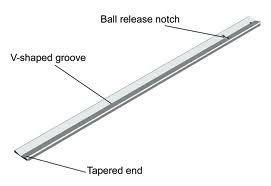Normally, when we cut the greens, the mower’s blades work
horizontally, removing leaf tissue which dares to creep above the height of
0.100”. (Yes, that is one-tenth of one
inch above the surface, and yes, we do set the mowers using a gauge which
measures in thousandths of an inch.) However,
despite this extremely low mowing height, some turf will elude the blades due
to its prostrate growth habits. Years
ago, this could lead to “grainy” greens.
This is where verticutting comes into play.
But what exactly is verticutting? Well, by definition, verticutting is the
thinning of turfgrass by blades or wire tines that cut perpendicular to the
soil surface. As shown in the picture,
verticutting blades resemble “throwing stars,” assembled in a helix shape. When the blade depth is set at, or just below
the putting surface, the process is often referred to as
"grooming." During the growing
season this practice is performed once or twice per month as needed. Following the verticutting, the greens are
mowed as usual, and within a day, you can’t see the lines at all.
What are the benefits of verticutting? Verticutting provides several benefits. For the plant, it helps with thatch removal,
and promotes new growth of shoots, which leads to a denser stand of turf. And for the golfer, the result of
verticutting is a surface which is immediately smoother, and with increased
density and less lateral grain, a faster one.
With this cultural practice being used throughout the United
States, one has to question if there is even a grain of truth to Johnny Miller’s
frequent pronouncements that a course’s greens have grain.
 |
| Verticutting units attach to our triplex mowers and replace the greens cutting units. |







